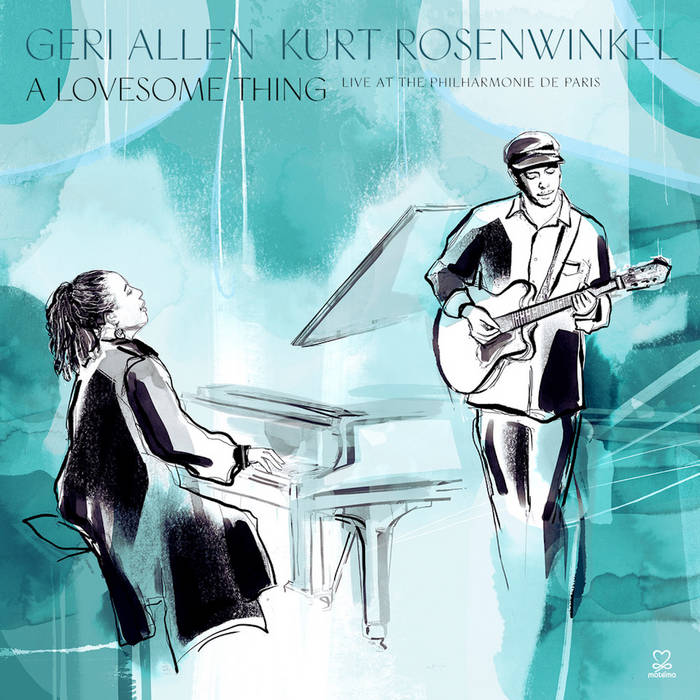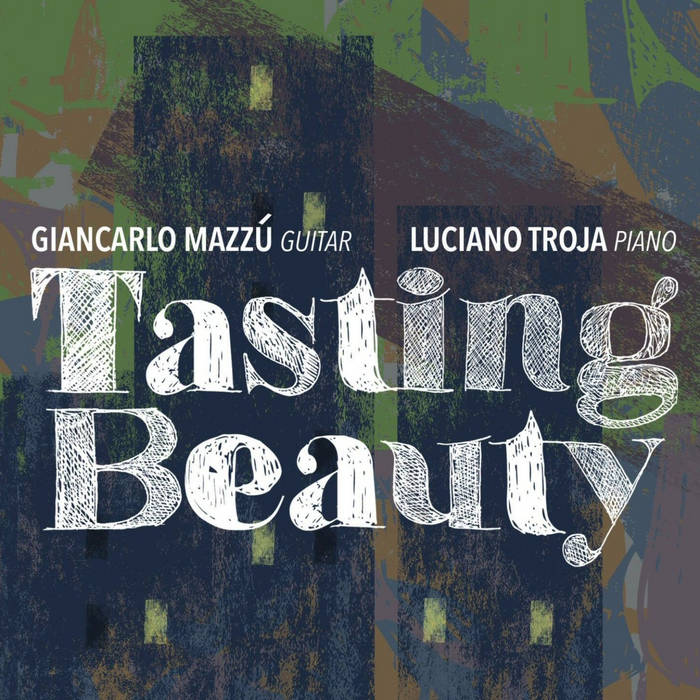Jazz Duos Piano Guitar
Die Jazz Gitarre Wikipedia:
Der Begriff Jazzgitarre bezeichnet die Rolle der Gitarre im Jazz, insbesondere die im Laufe der Jazzgeschichte entstandenen spezifischen Spiel- und Grifftechniken. Typisch sind der Einsatz von Jazz-Akkorden sowie das Akkord-Melodie-Spiel, bei dem Melodien mit Jazz-Harmonik harmonisiert werden.
Das Jazz-Piano Wikipedia:
Jazzpianisten weisen den Händen oft unterschiedliche Rollen zu. Im Solospiel kennt die linke Hand vielfältige Arten, die Basslinien und die Akkordprogressionen zu gestalten, die rechte Hand übernimmt in ebenso vielfältiger Weise vor allem die Melodielinien. Jazz-Piano-Spiel im Ensemble verlangt eine jeweils angemessene, gegebenenfalls sparsame Auswahl aus diesen Möglichkeiten
Soweit Wikipedia. In der Reihe Jazz Duos scheint durch: je mehr du siehst oder hörst, desto mehr gibt es zu hören und zu sehen, daher wir die Veröffentlichung des Projekts Chroma von Gilles Grethen Sebastian Voltz zum Anlass nehmen, eine kleine und eigene Reihe zu platzieren, in der der Duo Jazz um seine Instrumentenzusammenstellung kreist: um Duoaufnahmen von Piano und Gitarre.
Das Klavier gilt landläufig als laut, die Gitarre, zumindest die klassische Gitarre, als eher leise, das sollte sich mit Aufkommen der Elektrischen grundsätzlich ändern: die Verhältnisse kehrten sich um, sosehr, dass sich die Soli zwischen Gitarre und Klavier, B3 oder Grand-Piano bis in die Stadionbühnen hinein verbreiteten, vor allem in der Ära mit The Allman Brothers Band, mit Gratefull Dead oder eben mit Deep Purple. Wer erinnert sich nicht an die Duelle zwischen Richy Blackmore und Jon Lord? Wer nicht an das Zusammenwirken der Allman Brothers, wo Gregg (organ) und Duane (guitar) Allmann sich gegenseitig einheizten. Wer erinnert sich nicht an die rockopernhafte Bohemien Rapsody von Queen – wo erst das Klavier intoniert (auch oder gerade Freddy Mercury) und sich aber die Gitarre von Brian May meldet.
Im Jazz hatte mit Charlie Christian die elektrisch verstärkte Gitarre Einzug gehalten, (He was among the first electric guitarists and was a key figure in the development of bebop and cool jazz) Ein erstes Gitarrensolo soll Eddie Durham bei Jimmie Lunceford gespielt haben, weitgehend auf einer Saite (Hörbeispiel). Einen regelrechten Boom erfährt die E-Gitarre des Jazz in den 1950er und 1960er Jahren, die Namen dieser Zeit sind noch heute leitbild- und stilprägend:
Tal Farlow, Kenny Burrell, Barney Kessel und Herb Ellis (die beiden letzten in Trios von Oscar Peterson sowie als Bandleader), Grant Green, Joe Pass, Jimmy Raney, Wes Montgomery und George Benson. Eine erste Duo-Aufnahme Piano Gitarre ließe sich unter Oscar Peterson vermuten, substrahiert man aus den Trios Bass oder Schlagzeug. Im Rolling Stone wird aber Nat King Cole angeführt als einer der ersten mit einem Trio Klavier, Gitarre, Bass. Zu verfolgen auf The Complete Recordings Of Nat King Cole Trio, deutlich zu hören: wie die Gitarre sehr Django-mäßig swingt.
Im Zusammenspiel Klavier Piano ist Django Reinhardt mit Duke Ellington zu hören, wobei Ellington sich auf dem Piano rein auf rhythmische Begleitung beschränkt, dieses Zusammenspiel dürfte denn auch für die Entwicklung Gitarre im Zusammenspiel mit dem Klavier eher nachrangig sein. Trotzdem interessant. [Trotz seines Stolzes, mit Ellington auf Tournee zu gehen (einer von zwei Briefen an Grappelli berichtet von seiner Begeisterung), wurde er nicht vollständig in die Band integriert. Er spielte ein paar Stücke am Ende der Show, unterstützt von Ellington, ohne dass spezielle Arrangements für ihn geschrieben wurden – Django Reinhardt Wikipedia) In Rom dann spielt er mit Stephane Grapelli an der Violine und aber auch mit Gianni Safred und Ralph Schecron jeweils am Piano. Zu hören: Piano und Gitarre spielen eher neben- oder hintereinander her als arrangiert miteinander, jeder hat seinen ihm zugewiesenen Part.
Trios Gitarre – Klavier
Folgt man dem Rolling Stone Thread in der Triobesetzung Piano, Gitarre und Bass oder Drums, treten in der Folge Art Tatum mit Tiny Grimes an der Gitarre und Slam Stewart am Bass auf, Oscar Peterson, bevorzugt die Nat King Cole Besetzung, also Piano, Gitarre, Bass mit Barney Kessel an der Gitarre, gefolgt von Herb Ellis an der Gitarre und Ray Brown am Bass. Im Oscar Peterson Artikel der schlichte Satz steht: Peterson also worked in duos with Sam Jones, Niels-Henning Ørsted Pedersen, Joe Pass, Irving Ashby, Count Basie, and Herbie Hancock. Auch in den folgenden Aufnahmen gut zu hören: der Einfluss von Django Reinhardt:
Wer nun nachweislich die erste Duo-Aufnahme Gitarre Piano im Jazz vorgelegt hat, nun, da lege ich mir nach mehrstündiger Suche die Karten, es ist bestenfalls von den Greatest Guitar- oder Pianoplayers die Rede, eine der ersten Jazz Duo Aufnahmen Piano Guitar, die unser Feld berührt, ist die Aufnahme Undercurrent (1962) von Bill Evans mit Jim Hall, erstmal nur eine Randnotiz. Lassen wir uns lieber faszinieren von den in den folgenden sechzig Jahre entstandenen Aufnahmen, hier die Vorschläge für eine erste Runde.
Duos Gitarre – Klavier, Organ

von Sylvie Courvoisier & Mary Halvorson

Chroma, Gilles Grethen, Sebastian Voltz
Review

Gild Goldtein an Hammond
1976

Youtube
1994

von Kurt Rosenwinkel & Geri Allen
recorded 2012

von Max Light and Julian Shore
2023

von Giancarlo Mazzù & Luciano Troja
2015
Klassik Duos Piano Guitar
Klassik Gitarre Wikipedia:
The classical guitar, also known as Spanish guitar, is a member of the guitar family used in classical music and other styles.
Das Piano Das Klavier Wikipedia:
Klavier (von lateinisch clavis
„Schlüssel“; mittellateinisch clavis
„Taste“) bezeichnet heute das moderne, weiterentwickelte Musikinstrument Hammerklavier, also ein Saitenklavier, bei dem auf Tastendruck über eine spezielle Mechanik Hämmerchen gegen Saiten geschlagen werden. Die ebenfalls übliche Bezeichnung Pianoforte, oder verkürzt Piano, entstand, weil das Hammerklavier erstmals die Möglichkeit bot, die Lautstärke jederzeit stufenlos zwischen leise (piano) und laut (forte) durch die Anschlagstärke zu verändern, anders als beispielsweise das Cembalo, bei dem die Saiten von einer Mechanik gezupft werden. Die heutigen Hauptformen des Klaviers sind der Flügel (englisch grand piano) und das Pianino (aufrechtes Klavier, englisch upright piano). Letzteres wird heute fast immer als Klavier bezeichnet und oft mit diesem Begriff gleichgesetzt.

YOUTUBE


YOUTUBE

YOUTUBE
Jazz Duos Piano Guitar
English
The jazz guitar Wikipedia:
The term jazz guitar refers to the role of the guitar in jazz, in particular the specific playing and fingering techniques that have developed over the course of jazz history. Typical are the use of jazz chords and chord-melody playing, in which melodies are harmonized with jazz harmony.
The jazz piano Wikipedia:
Jazz pianists often assign different roles to the hands. In solo playing, the left hand has many different ways of shaping the bass lines and chord progressions, while the right hand takes on the melody lines in just as many different ways. Jazz piano playing in an ensemble requires an appropriate and, if necessary, sparing selection from these possibilities
So much for Wikipedia. In the Jazz Duos series, the more you see or hear, the more there is to hear and see, which is why we are taking the publication of the Chroma project by Gilles Grethen Sebastian Voltz as an opportunity to place a small and separate preview series in which Duo Jazz now revolves around its instrumental combination: in this case, piano and guitar.
The piano is generally regarded as loud, the guitar, at least the classical guitar, as rather quiet. This was to change fundamentally with the advent of the electric guitar: the proportions were reversed, so much so that solos between guitar and piano, B3 or piano spread to the stadium stages, especially in the era with The Allman Brothers Band, with Gratefull Dead or even with Deep Purple. Who doesn’t remember the duels between Richy Blackmore and Jon Lord? Who doesn’t remember the collaboration between the Allman Brothers, where Gregg (organ) and Duane (guitar) Allmann heated each other up? Who doesn’t remember the rock-operatic Bohemian Rapsody by Queen – where the piano plays first (of course Freddy Merciry does, too) and then Brian May’s guitar joins in.
The electrically amplified guitar also found its way into jazz with Charlie Christian (He was among the first electric guitarists and was a key figure in the development of bebop and cool jazz). Eddie Durham is said to have played his first guitar solo with Jimmie Lunceford, largely on one string (audio sample). The electric guitar experienced a real boom in jazz in the 1950s and 1960s, and the names of this period still set the tone and style today:
Tal Farlow, Kenny Burrell, Barney Kessel and Herb Ellis (the last two in trios with Oscar Peterson and as bandleader), Grant Green, Joe Pass, Jimmy Raney, Wes Montgomery and George Benson. A first piano-guitar duo recording could be assumed to be by Oscar Peterson, if one subtracts bass or drums from the trios, but in Rolling Stone Nat King Cole is listed as one of the first with a piano, guitar, bass trio. This can be heard clearly on The Complete Recordings Of Nat King Cole Trio: how the guitar swings like Django.
Django Reinhardt can be heard playing piano with Duke Ellington, although Ellington confines himself purely to rhythmic accompaniment on the piano; this interplay is probably of secondary importance for the development of the guitar in combination with the piano. Interesting nonetheless. [Despite his pride in going on tour with Ellington (one of two letters to Grappelli reports his enthusiasm), he was not fully integrated into the band. He played a few pieces at the end of the show, backed by Ellington, without any special arrangements being written for him – Django Reinhardt Wikipedia) In Rome he played with Stephane Grapelli on violin and also with Gianni Safred and Ralph Schecron on piano. To be heard: Piano and guitar play alongside or behind each other rather than arranged together, each has its own assigned part.
If you follow the Rolling Stone thread in the trio line-up piano, guitar and bass or drums, Art Tatum with Tiny Grimes on guitar and Slam Stewart on bass appear in the following, Oscar Peterson, prefers the Nat King Cole line-up, i.e. piano, guitar, bass with Barney Kessel on guitar, followed by Herb Ellis on guitar and Ray Brown on bass. The Oscar Peterson article simply states: Peterson also worked in duos with Sam Jones, Niels-Henning Ørsted Pedersen, Joe Pass, Irving Ashby, Count Basie, and Herbie Hancock. The influence of Django Reinhardt can also be heard in the following recordings:
he has now demonstrably presented the first duo recording guitar piano in jazz, well, after several hours of searching, I lay down my cards, at best there is talk of the Greatest Guitar- or Pianoplayers , one of the first jazz duo recordings piano guitar that touches our field is the recording Undercurrent (1962) by Bill Evans with Jim Hall, a marginal note, let us rather be fascinated by the recordings made over the following sixty years, here are the suggestions for a first round.



































